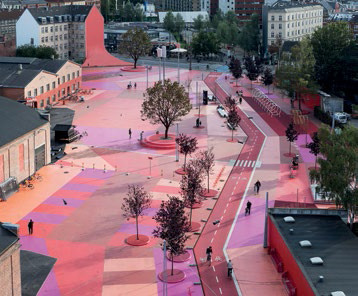Visionary architects are redefining urbanism by merging infrastructure with public spaces.


With the world’s population inching towards eight billion, city size – and not necessarily density – is becoming a pressing problem for urban architects and city planners.
Cities such as Los Angeles and Brisbane suffer from urban sprawl, a phenomenon characterised by low-density housing, single-use developments and haphazard planning. As such, it is inefficient at housing a growing population and incurs other externalities, including the increased use of automobiles to get around. Areas with high population densities, on the other hand, are often unsafe and stressful to live in.
This conundrum has pushed city planners and designers to start looking for a balanced solution and the answer seems to lie in mixed-use buildings.
At the forefront of this push is one of the world’s most liveable cities. Scoring a 96.8 in the Global Liveability Index 2019, Copenhagen is feted for its use of extensive cycling networks to replace cars, only made possible because of its outstanding architecture and the residents’ love for the outdoors.
The city is aiming to be carbon neutral by 2025 and has started initiatives such as a green roofs policy, which dictates that new buildings with roof slopes of less than 30 degrees must have vegetation grown on them. Beyond sustainability, it’s a commitment to rethinking how we use architecture to serve the needs of everyone.
Danish designer Bjarke Ingels believes public infrastructure is too often left in the realm of civil engineering. He feels that with a touch of ingenuity, these utilitarian buildings can become something for people to enjoy. This is in line with his ethos of hedonistic sustainability that challenges the perceived compromise that sustainability entails.
Enter Copenhill by the Bjarke Ingels Group (BIG). It’s a waste-toenergy plant that doubles as an urban recreation centre (pictured, left). An artificial rooftop ski slope, hiking trail and the world’s largest climbing wall – 80m tall – sit atop a clean-energy plant that annually converts 440,000 tons of waste into energy.
It is no longer an eyesore occupying vital acreage in one of Copenhagen’s densest districts, but a welcome amenity that attracts visitors from the region and beyond.
Dutch-based developer MVRDV is another advocate of the value of mixed-use developments. It recently won a global competition to design the Shimao Shenkong International Centre in Shenzhen, thanks to its innovative entry called Shenzhen Terraces that edged out 26 other competitors.
“In cities like this, it is essential to carefully consider how public spaces and natural landscape can be integrated into the densifying cityscape,” says Winy Mass, MVRDV’s founding partner.
Here in Singapore, the Urban Redevelopment Authority also updated its Landscaping for Urban Spaces and High-rises (LUSH) programme in 2017. Christened LUSH 3.0, it emphasises rooftop greenery and urban farming or solar panels to make better use of space in high-rise developments.
Mixed-use developments may not be a silver bullet to eliminate urban sprawl, but they are an indication of the directional shift in urbanism and how city planners and architects are designing for the future.
1 COPENHILL

2 PARK ‘N’ PLAY

SHENZHEN TERRACE
TEXT ALVIN LIM























